- Home
- Mark R. Levin
Plunder and Deceit Page 2
Plunder and Deceit Read online
Page 2
Anomalies can be difficult to unravel; however, a few observations are merited. As a general and logical matter, younger people’s dearth of life experiences and their quixotic idealism make them especially vulnerable to simplistic appeals and emotional manipulation for utopia’s grandiosity and social causes, which are proclaimed achievable only through top-down governmental designs and social engineering and, concurrently, the detachment from and deconstruction of societal traditions, customs, and values, for which they have little or modest conception and investment. Consequently, while in the main and abstractly the rising generation may be distrustful of authority and people, younger people are also especially susceptible to seduction by demagogic politicians, propagandizing academics, charismatic cultural idols, and other authority and popular figures propounding splendid notions of aggressive government activism for and through such corresponding militant causes as “social justice,” “environmental justice,” “income equality,” and other corollaries of radical egalitarianism.
In Liberty and Tyranny, I explained that this way of thinking “all but ignores liberty’s successes in the civil society in which humans flourish, even though [we are] surrounded in [our] every moment by its magnificence. . . . Liberty’s permeance in American society often makes its manifestations elusive or invisible to those born into it. Even if liberty is acknowledged, it is often taken for granted and its permanence assumed. Therefore, under these circumstances, the Statist’s agenda can be alluring. . . . It is not recognized as an increasingly corrosive threat to liberty but rather as co-existing with it.”11
Inasmuch as the proclaimed injustices and imperfections of the civil society are presumably illimitable, so are the infinite reactionary governmental prescriptions and interventions allegedly required to abate them. Therefore, government activism and social designs in this context are perceived as routine, indispensable, and noble. However, the erosion of individual sovereignty, free will, and self-sufficiency necessarily give way to dependence, conformity, and finally tyranny.
Although the pattern is not unique to the rising generation, younger people often find self-esteem, purpose, passion, and, frankly, coolness when associated with or devoted to causes and movements self-proclaimed as righteous or even sacred. Eric Hoffer, the brilliant longshoreman philosopher, writing about the nature of mass movements, declared: “The prime objective of the ascetic ideal preached by most movements is to breed contempt for the present. . . . The very impracticability of many of the goals which a mass movement sets itself is part of the campaign against the present.”12
These utopian causes and movements are evinced by demands for assorted forms of expanded statism—increased governmental usurpations and empowerment—which invariably contribute to the deterioration of the civil society. To be clear, however, the rising generation is among the most devoted advocates of activist government. Consequently, it cannot be said to rebel against authority, although its members may believe that they do, but sanction its exercise and abuse in an incrementally severe centralized government, the latter of which, and its effects, have steadily emerged as the predominant characteristic of the actual status quo.
In particular, undergirding the rising generation’s ethos in this regard is the relentless indoctrination and radicalization of younger people, on a daily basis and over the course of many years, from kindergarten through twelfth grade to higher education in colleges and universities, which engrains within them a vulnerability to exploitation and zealotry. It builds among them acceptance or even clamor for self-destructive policies and conditions that ensure future economic and political instability.
Even the most diligent parents have little effective input into what their children are taught in these classrooms. Indeed, they have no adequate or routine influence in the selection of teachers and professors, curriculum, or textbooks, which principally advance, either openly or through insinuation, a statist agenda and ideological groupthink hostile to the civil society and the American heritage. The immunization of formal education from parental and community input is a monumentally disastrous event. Professor Bruce Thornton of California State University observes that the project is deceitful and insidious: “The founding of the United States . . . was not about things like freedom and inalienable rights, but instead reflected the economic interests and power of wealthy white property-owners. The civil war wasn’t about freeing the slaves or preserving the union, but about economic competition between the industrial north and the plantation south. The settling of the West was not an epic saga of hardships endured to create a civilization in a wilderness, but genocide of the Indians whose lands and resources were stolen to serve capitalist exploitation. Inherent in this sort of history were the assumptions of Marxist economic determinism and the primacy of material causes over the camouflage of ideals and principles.”13
In fact, Thornton’s point about the perversion of formal education as a format for class warfare proselytizing is the modern American version of a central theme in The Communist Manifesto. Its authors, Karl Marx and Friedrich Engels, argued: “The history of all hitherto existing society is the history of class struggles.”14 They continued, “Freeman and slave, patrician and plebeian, lord and serf, guild master and journeyman, in a word, oppressor and oppressed, stood in constant opposition to one another, carried on an uninterrupted, now hidden, now open fight, that each time ended, either in the revolutionary reconstitution of society at large, or in the common ruin of the contending classes.”15
By cultivating agitation and balkanization almost nothing about the civil society is said to be true, right, or lasting and, therefore, worth preserving and perpetuating. Instead, much uproar is generated in the quest for utopian abstractions and societal transformation—the fundamental cause around which younger people have been encouraged and trained to rally, to their detriment and the jeopardy of subsequent generations, and to the benefit of the statist.
The ominous signs of the rising generation’s imperilment from these ideological contrivances are already abundant. For example, respecting contemporary social and economic conditions, Pew Research reports that today’s younger people “are . . . the first in the modern era to have higher levels of student loan debt, poverty and unemployment, and lower levels of wealth and personal income than their two immediate predecessor generations had at the same stage of their life cycles.”16 Specifically, at the end of 2012, individuals under 40 had $645 billion in student loan debt, an increase of 140 percent since 2005.17 In 2014, unemployment for individuals between the ages of 16 and 19 hovered around 20 percent18 and the underemployment rate for recent college graduates stood at 46 percent.19 Among those aged 25 to 32 today, 22 percent with only a high school diploma are living in poverty compared to 7 percent of individuals aged from approximately 49 to 67 years of age who had only a high school diploma in 1979 when they were in their late twenties and early thirties.20
In a separate study, Pew also found that “Young adults ages 25 to 34 have been a major component of the growth in the population living with multiple generations since 1980—and especially since 2010. By 2012, roughly one-in-four of these young adults (23.6%) lived in multi-generational households, up from 18.7% in 2007 and 11% in 1980.”21
Furthermore, the Congressional Budget Office (CBO), an appendage of Congress, reports that without a dramatic change in federal government spending, “[t]wenty-five years from now . . . federal debt held by the public [will] exceed 100 percent of GDP. . . . [D]ebt would be on an upward path relative to the size of the economy, a trend that could not be sustained indefinitely.” In addition, “[b]eyond the next 25 years, the pressures caused by rising budget deficits and debt would become even greater unless laws governing taxes and spending were changed. With deficits as big as the ones that CBO projects, federal debt would be growing faster than GDP, a path that would ultimately be unsustainable.” The CBO concludes: “At some point, investors would begin to doubt the government’s willingness or ability to pay its d
ebt obligations, which would require the government to pay much higher interest costs to borrow money. Such a fiscal crisis would present policymakers with extremely difficult choices and would probably have a substantial negative impact on the country. Even before that point was reached, the high and rising amount of federal debt that CBO projects under the extended baseline would have significant negative consequences for both the economy and the federal budget.”22
Thomas Jefferson presciently warned against such immoral collective behavior: “We believe—or we act as if we believed—that although an individual father cannot alienate the labor of his son, the aggregate body of fathers may alienate the labor of all their sons, of their posterity, in the aggregate, and oblige them to pay for all the enterprises, just or unjust, profitable or ruinous, into which our vices, our passions or our personal interests may lead us. But I trust that this proposition needs only to be looked at by an American to be seen in its true point of view, and that we shall all consider ourselves unauthorized to saddle posterity with our debts, and morally bound to pay them ourselves; and consequently within what may be deemed the period of a generation, or the life of the majority.”23 A few years later, Jefferson expressed even more trepidation: “[With the decline of society] begins, indeed, the bellum omnium in omnia [the war of all against all], which some philosophers observing to be so general in this world, have mistaken it for the natural, instead of the abusive state of man. And the fore horse of this frightful team is public debt. Taxation follows that, and in its train wretchedness and oppression.”24
The laws of economics, like the laws of science, are real, unlike the utopian images and empty assurances of expedient and self-aggrandizing politicians and bureaucrats. There is a point of irreversibility from which no generation and the larger society can recover. Moreover, just as economic and political liberty are intertwined, spreading economic instability leads to political turmoil and, ultimately, societal disorder or collapse. In the interim, as this process unfolds, the dissolution of constitutional republicanism—including representative and consensual governance, dispersed authority among federal branches and between the federal and state governments, and the empowerment of a pervasive federal administrative state incessantly insinuating itself into the lives of the people—becomes regular and routine. The ensuing amalgamation of governmental control, and the escalating police powers discharged to coerce and subjugate the individual through multitudinous rules, regulations, taxes, fines, and penalties, confounds and benumbs much of the citizenry. Furthermore, the designed societal transformation and decay of enlightened self-government are portrayed as compassionate, progressive, and inevitable.
Nonetheless, the federal colossus will not reform itself and self-surrender its design. Its advocates, surrogates, and beneficiaries neither admit failure nor entertain circumspection. They are increasingly fanatical as they insist on more zealous applications of their ideological preoccupations and societal schemes.
The time is urgent for the ruling generation and the rising generation—that is, parents and their progeny—to step up in defense of their joint interests and in opposition to their common foe—a government unmoored from its constitutional beginnings and spinning out of control. The statist abuses and exploits younger people and subsequent generations, expropriating the fruits of their labor and garnishing wealth yet created, as a cash cow for voracious, contemporary governmental plundering, and manipulating and constricting their prospects and liberty even before they are of age to more fully pursue and enjoy them. The ruling generation, upon sober reflection, must stir itself to action in order to untangle the web of societal and generational conflicts produced by the statists’ endless and insidious social engineering and encroachment, even though it requires some level of economic self-sacrifice and partial withdrawal from governmental entitlements and subsidies.
The equally formidable struggle for younger people is first to recognize the constant and self-reinforcing influences of statist manipulation and exploitation, break loose from them, and then rally against them in their own defense. The rising generation must question, confront, and civilly resist the real authoritarianism that endangers its future and the quality of life of those not yet born, whether preached in the classroom, popularized through entertainment, or idealized by demagogic politicians. Their well-being as a free, self-sufficient, and thriving people is at stake. The real fight they must wage is against utopian statism, which grows at the expense of the civil society and their own security and happiness. Otherwise, the rising generation—and unborn, unrepresented generations that follow—will degenerate into a lost and struggling generation, living an increasingly bleak and hollow existence under steadily more centralized, managed, and repressive rule.
At the beginning of this chapter I asked: Can we simultaneously love our children but betray their generation and generations yet unborn? The answer is no. I also asked: Do younger people wish to be free and prosperous? Do they have a responsibility to preserve their own well-being and that of subsequent generations by resisting societal mutation and economic plunder? The answer to both questions is yes. It turns out that the ruling and the rising generations have much in common after all.
In the first place and in the end, we must rely on our individual and collective capacity, albeit imperfect and fallible, for sound judgment and right reason. There are eternal and unchangeable universal truths that no professor, politician, expert, or combination thereof can alter or invalidate. The mission of this book, as in my past books, is to persuade as many fellow citizens as possible, through scholarship, facts, and ideas, to avert a looming tragedy—not a Greek tragedy of the theater and mind, but a real and devastating American tragedy, the loss of the greatest republic known to mankind.
TWO
* * *
ON THE DEBT
GEORGE MASON UNIVERSITY ECONOMICS professor Dr. Walter Williams rightly describes the underlying pathology driving the nation to economic and financial ruin as a moral problem: “We’ve become an immoral people demanding that Congress forcibly use one American to serve the purposes of another. Deficits and runaway national debt are merely symptoms of that real problem.”1 As Williams states, nearly 75 percent of today’s federal spending “can be described as Congress taking the earnings of one American to give to another through thousands of handout programs, such as farm subsidies, business bailouts and welfare.”2
Dr. Thomas Sowell, senior fellow at the Hoover Institute, Stanford University, notes that “There was a time when the purpose of taxes was to pay the inevitable costs of government. To the political left, however, taxes have long been seen as a way to redistribute income and finance other social experiments based on liberal ideology.”3
The consequences for the rising generation and future generations of the statists’ immoral, politically expedient, and economically ruinous behavior and policies are unambiguous as evidenced by statistic after statistic, which are mainly ignored, discounted, or excused by most of the media, academia, and, of course, governing statists. Nonetheless, there is no mistaking the eventual societal turmoil these facts and figures portend—evidence all Americans, and especially younger people, must heed.
The nation’s fiscal operating debt was already $10.6 trillion on the day President Barack Obama took office in January 2009. By the end of January 2012, however, the fiscal operating debt had increased 44.5 percent to $15.4 trillion. As of April 12, 2015, the fiscal operating debt was $18.152 trillion—a 71 percent increase in less than six and one half years.4 Each man, woman, and child in this country’s share of the national debt has grown from $33,220 at the beginning of the Obama presidency to more than $56,900 today.5 To be sure, the debt habit began long before the Obama presidency, but it is now a full-blown addiction.
During the Obama administration, government spending and borrowing have both sky-rocketed. The financial bailouts and expanded social spending during the prior administration of George W. Bush contributed mightily to the federal
government’s debt. In fact, Bush is second only to Obama in the amount of debt in absolute dollars with which he burdened younger people and future generations.6 But with the addition of the massive Patient Protection and Affordable Care Act program, or Obamacare, and other profligate spending programs, including some $800 billion for the American Recovery and Reinvestment Act of 2009, or “stimulus program,” there is no denying that the past several years have created historic records for yearly deficits and overall debt.7
As C. Eugene Steuerle of the Urban Institute explained: “Over decades, we have wound [a] straight jacket policy around ourselves. Especially in retirement, health and taxation—budget areas where now-dead or retired members of Congress inscribed permanent policies—annual decision-making and regular review have been choked off and future generations saddled with the tab or forced to raise the resources to meet these past promises.”8
In July 2014, the nonpartisan Congressional Budget Office (CBO) released its annual Long-Term Budget Outlook. The document provides an extensive analysis of projected government spending, debt, and obligations. It reported that between 2009 and 2012, the federal government amassed the largest budget deficits relative to the size of the economy, the Gross Domestic Product (GDP), since World War II.9 These deficit levels were almost twice the percentage of the deficit at the end of 2008.10 Measured in dollars, the federal deficit in 2008 was nearly half a trillion dollars.11 By 2012, the deficit was $1.4 trillion.12 In 2014 alone the federal budget deficit was larger than the combined market capitalization of Apple Computers, Exxon Mobil Corporation, and Microsoft—three of the world’s largest corporations.13

 The Liberty Amendments: Restoring the American Republic
The Liberty Amendments: Restoring the American Republic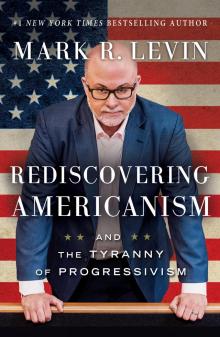 Rediscovering Americanism: And the Tyranny of Progressivism
Rediscovering Americanism: And the Tyranny of Progressivism Plunder and Deceit: Big Government's Exploitation of Young People and the Future
Plunder and Deceit: Big Government's Exploitation of Young People and the Future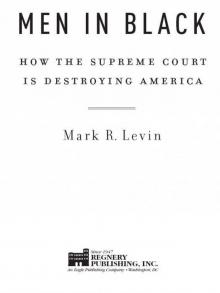 Men in Black: How Judges Are Destroying America
Men in Black: How Judges Are Destroying America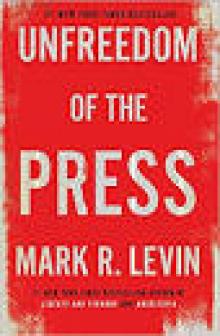 Unfreedom of the Press
Unfreedom of the Press Ameritopia: The Unmaking of America
Ameritopia: The Unmaking of America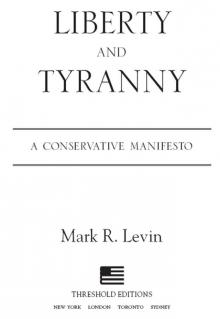 Liberty and Tyranny
Liberty and Tyranny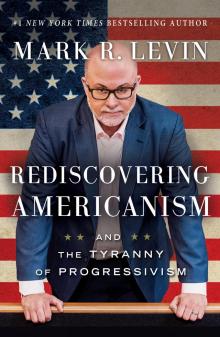 Rediscovering Americanism
Rediscovering Americanism Ameritopia
Ameritopia Plunder and Deceit
Plunder and Deceit